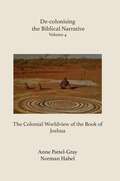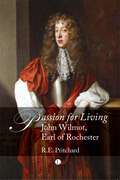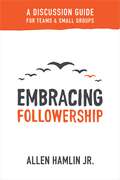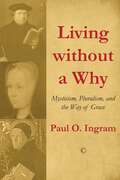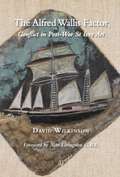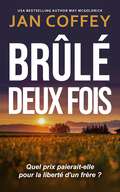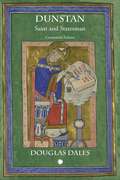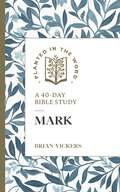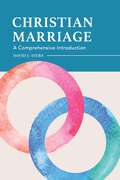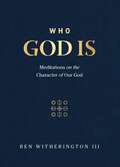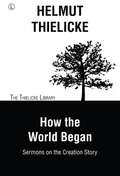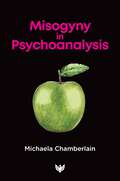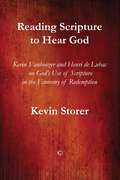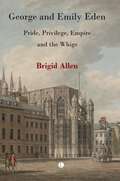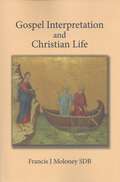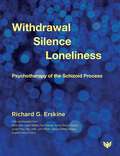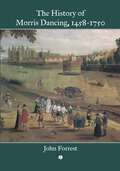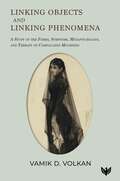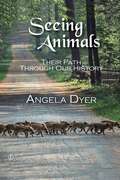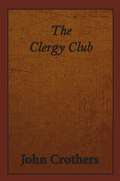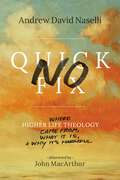- Table View
- List View
De-colonising the Biblical Narrative: The Colonial Worldview of the Book of Joshua
by Anne Pattel-Gray and Norman HabelVolume Four in the De-colonising the Biblical Narrative Series is dedicated to those First Nations Australia peoples who were encouraged who were informed by invading colonists, that Australia or other lands, was The Promised Land for the colonials, like the Land of Canaan, colonised by Joshua, in the name of the Colonial God YHWH whose merciless techniques, are outlined, by a Colonial Narrator in the Book of Joshua. The true message of The Book of Joshua has long been hidden. In Sunday School, in church sermons, in seminaries or in most interpretations of this book, Joshua has been viewed as a hero of a great God who enabled his people to escape from Egypt and to settle in the Promised Land. The colourful Crossing of the Jordan, the spectacular Fall of Jericho and the Sun Standing Still were viewed as amazing portraits of how the God of Israel enabled Israel to enjoy entering The Promised Land. There is only one way First Nations people can interpret Joshua but from a colonising point of view, as it is clear the colonial God favours one race of people over that of another. Colonists have over the centuries used the Book of Joshua as the bases for their justification to invade, colonise, steal lands, massacre First Nations people and enslave them.
Passion For Living: John Wilmot, Earl of Rochester
by R E PritchardJohn Wilmot, Earl of Rochester (1647-1680), has long been notorious as one of the most entertaining, extravagant and scandalous members of Charles II's court. He was also the most brilliant, witty and insightful satirist and lyric poet of his time, limited only by his early death caused by venereal disease and alcoholism. Passion for Living provides a full discussion of his life and writings, set in the context of his Times - the licentious court of Charles II and his mistresses, the Dutch warsand the so-called Popish Plot - together with close readings and analyses of his love lyrics, bawdy songs and shrewd satires, related to the life of his contemporaries, such as Thomas Hobbes, Samuel Butler and John Dryden. This informative and readable study will be of interest to both the general reader and the student.
Embracing Followership: A Discussion Guide for Teams & Small Groups
by Allen Hamlin Jr.We live in a leader-centric culture. But what if leadership isn't our goal? Can we use our skills to perform with excellence—as followers? In Embracing Followership, Allen Hamlin Jr. showed that you don't need to be a leader to make a difference. In this 16-part study guide to the book, you'll discover what following well looks like in your own life—unpacking key themes from Embracing Followership and looking to role models in the Bible for guidance on how to thrive as a follower. Additional discussion questions will also spark conversation among leaders and followers walking through the guide in a group setting. Embrace your role as a follower more fully with the Embracing Followership discussion guide!
Living without a Why: Mysticism, Pluralism, and the Way of Grace
by Paul O IngramIn this book Paul O. Ingram adds his voice to a long list of writers seeking to relate Christian tradition to the hard realities of this post-Christian age of religious and secular pluralism. As a Lutheran, Ingram thinks grace flows over this universe like a waterfall. So he brings Christian mystical theology into a discussion of the meaning of grace. Alfred North Whitehead's philosophical vision provides a language that serves as a hermeneutical bridge by which historians of religions can interpret the teachings and practices of religious Ways other than their own without falsification, and by which theologians can appropriate history-of-religions research as a means of helping Christians advance in their own faith journeys. The purpose of the journey of faith is what Whitehead called creative transformation. The contemporary theological tradition that has most systematically and coherently followed Whitehead's lead in its reflection on non-Christian Ways is process theology,which is perhaps the only liberal or progressive theological movement now active in the twenty-first century.
Ángel de Skye (La Familia Macpherson)
by Jan Coffey May McGoldrickGanador del Medallón Holt al Mejor Romance Histórico Desde las costas azotadas por el viento de Escocia hasta las cortes más lujosas de Europa, Ángel de Skye nos sumerge en una épica historia de amor, secretos y traición en los turbulentos días del reinado de Henry VIII. Fiona, una joven con el cabello como fuego y un pasado borrado por el tiempo, ha sido criada en un monasterio de la isla de Skye sin recuerdos de su linaje. Pero cuando el destino la pone en el camino del guerrero Alec Macpherson, un hombre leal al trono escocés y marcado por la guerra, su mundo da un vuelco. Alec está dispuesto a protegerla con su vida. Pero Fiona guarda un secreto que ni ella misma comprende del todo: un recuerdo enterrado que podría revelar al asesino de su madre y desestabilizar el futuro de Escocia. Entre batallas, pasiones y conspiraciones, Alec y Fiona deberán decidir si su amor puede sobrevivir en un mundo donde la verdad puede ser tan peligrosa como una espada. Una novela inolvidable de pasión, coraje y redención — donde el amor no solamente salva, sino que también desafía a reyes.
The Alfred Wallis Factor: Conflict in Post-War St Ives Art
by David WilkinsonSince his death in 1942, St Ives has become marinated in the spirit of the naive painter, Alfred Wallis. Naum Gabo, the Russian Constructivist, felt that Wallis's gift as an artist was that he never knew he was one. His unconventional approach and the innocence of his personal method of making art marked Alfred Wallis, even after his death, as a crucial figure in the modernist movement. The art scene in St Ives during World War II is depicted vividly in The Alfred Wallis Factor which illustrates the birth of modernism in the small fishing port in the far south-west of England. With dominant personalities like Sven Berlin, Ben Nicholson, Barbara Hepworth, Adrian Stokes, Bernard Leach, Terry Frost, Peter Lanyon, Wilhelmina Barns-Graham and Patrick Heron, it was inevitable that personal relationships would both form and fracture. Though causes would range from the banal to the bizarre, David Wilkinson never loses focus on the high stakes for which these characters were playing: the creation of their work, and reputations, of lasting significance. Their passion was strong and their ambition even stronger. The Alfred Wallis Factor tells the story of this extraordinary painter's long-lasting influence on - and beyond - modernism: David Wilkinson expounds the events around and following the artist's death, assessing the roles of friends and rivals in making Alfred Wallis a benchmark of modern British art. The Alfred Wallis Factor is a comprehensive examination of a troubled era, in which life met war and changed the destiny of the art world.
Brûlé Deux Fois
by Jan Coffey May McGoldrickLa peine de mort - un verdict unanime contre Ted Hardy pour les meurtres de sa femme, Marilyn, et de ses deux jeunes filles. Stonybrook se réjouit. Il est temps de punir cette famille maudite, de l'enfermer à jamais. Les Hardy n'ont-ils pas toujours été la honte de la ville ? Déjà, le père, une vingtaine d'années plus tôt, avait tué sa femme avant de se suicider... C'est dans ce climat de préjugés que Léa Hardy revient à Stonybrook. Léa sait que son frère est innocent des crimes dont on l'accuse, tout comme elle sait qu'il aimait ses enfants et que, malgré son divorce en cours, il n'aurait jamais pu poignarder sa femme. Alors qui est le véritable meurtrier ? La réponse se trouve ici, dans la ville où elle a grandi. Une ville où, sous ses dehors charmants, se cache un monde de vieux secrets, d'âmes blessées et de cœurs maléfiques. Une ville capable du meilleur, mais aussi du pire. A PROPOS DE L'AUTEUR Sous ce pseudonyme se cache en réalité un couple, Jim et Nikoo McGoldrick. En quelques années, ils ont accumulé les nominations et les prix, grâce à leurs talents conjugués. Leurs auteurs favoris, de Jane Austen à Nora Roberts, témoignent de leur goût pour le suspense et l'atmosphère - deux veines qu'ils explorent à merveille dans leurs romans. Brûlé Deux Fois PRIX D'EXCELLENCE DAPHNE DU MAURIER Gagnant PRIX NATIONAL DU CHOIX DES LECTEURS FINALISTE FINALISTE DU PRIX RWA RITA
Dunstan: Saint and Statesman
by Douglas DalesSt Dunstan of Canterbury (909-88) was the central figure in the development of English church and society after the death of King Alfred. Douglas Dales traces Dunstan's life beginning with his education at the great monastery of Glastonbury of whichhe became abbot. He was a central figure at the court of the kings of Wessex but was banished, partly because of his hostility to the king's mistresses, and went to exile in Flanders. After his return he was appointed Archbishop of Canterbury. During the twenty-eight years of his primacy he carried out one of the major developments of the century, the reformation of the monasteries. This book aims to examine him not merely as a prelate and royal advisor, but to see other aspects of his life: his skills as a craftsman caused him to be adopted as the patron saint of goldsmiths; some of his work as calligrapher and artist survives to this day; the coronation service which he drew up still lies at the heart of this service for English monarchstoday; he was famed for his musical skills; above all, the sanctity of his name and the fame of his miracles kept Dunstan's memory alive. Douglas Dales' re-examination of the life and times of Dunstan sets his achievements against the social and religious background of the day, at a time when new forces were emerging that would shape the future of England and the English Church for centuries to come.
Mark: A 40-Day Bible Study (Planted in the Word)
by Brian Vickers"WHO DO YOU SAY THAT I AM?" — MARK 8:29 Jesus asked his disciples this question, and no question is more important. The Gospel of Mark answers by presenting Jesus as the king who suffered and gave his life for us and invited us to take up our cross and follow him. Mark: A 40-Day Bible Study is meditative, gospel-centered, practical, and prayerful. Over forty days, you will: Read and reflect on Mark's Gospel. Meditate on Jesus and the good news he brings. Pray through Mark's Gospel. Apply Mark's Gospel to your life. Planted in the Word: Bible studies for individuals or small groups. Each volume provides forty days of guided Bible study written by respected scholars for everyday Christians. Short enough to read in 15 minutes or less, each day includes: Reading and meditation on Scripture Reflection on how the text points to Christ Application of God's word to our lives Praying for God's help Suggestions for further study or discussion. Each volume includes a reading plan for group study.
Christian Marriage: A Comprehensive Introduction
by David AyersWhy should we care about marriage? There is a lot of confusion about the purpose of marriage todayâ€"outside the church as well as within it. Written by a distinguished Christian sociologist, Christian Marriage is a theologically rich, biblically robust, and sociologically informed treatise on the nature and value of marriage. Drawing on recent social science research, empirical data, and social history, Ayers paints a picture of marriage as an institution meant for human flourishing. Along the way, Ayers addresses such topics as Dating and selection of a spouse The importance of premarital counseling Sex and procreation Mentoring and supporting unmarried believers Divorce and remarriage And current controversies surrounding premarital sex and same-sex marriage. Though the book is academically and theologically informed, it is written with a pastoral heart. It seeks to provide a rich resource for pastors and counselors on a topic of supreme importance to a vibrant church and society.
Who God Is: Meditations on the Character of Our God
by Ben WitheringtonDo you know the character of our God--do you know who God is? What does it mean to say that God is love, light, life, and spirit? In Who God Is, world-renowned New Testament scholar Ben Witherington III explores the nature and character of the God of the Bible by focusing specifically on the nouns used to describe who God is. This rich exploration has its foundation in a deep reading of the biblical text. Reflecting on these descriptions of God gives us a fresh understanding of the beauty and uniqueness of the character of our God.
How the World Began: Sermons on the Creation Story (Thielicke Library)
by Helmut ThielickeThe question of where we come from and where we are going is one of the elementary challenges of life. Perhaps it is the question of life. Only when we get an answer to it do we learn who we are. So begins How the World Began, a book that asks themost fundamental of all questions: who are we? And what did God intend us to be? Despite - perhaps even because of - the immense technological advances of our time, and the frightful consequences for the human race of the misuse of that power, humanity is brought face-to-face time and again with the essential problem that has haunted us since the beginning of time: the mystery of good and evil. Helmut Thielicke's work in these sermons on the first eleven chapters of Genesis is thought-provokingand exceptionally powerful.
Save Our Freedom: A Wake-Up Call in Digital Times
by Bijan MoiniFreedom is something we take for granted—a fundamental human right we assume will always be there, and that we complain about vocally when we feel it's being upon. But in reality, the number of countries in which people can live freely is decreasing for the first time in decades. Bijan Moini's new book is a jarring wake-up call: if we aren't careful, our freedoms may be stripped away, too, and it might be our own fault. Vividly describing the current landscape of civil liberties in our capitalistic and digital age, Save Our Freedom! explains the immense importance the principle plays in our day-to-day, and outlines concrete actionable measures to fight back.. TIMELY, IMPORTANT, AND URGENT: The voluntary ceding of freedoms is an alarming and highly relevant issue facing our digital world, and one that we are not giving sufficient attention. Save Freedom is a call to action to change our focus before it's too late.
Gefangene Träume (SCHOTTISCHEN TRAUM-TRILOGIE)
by Jan Coffey May McGoldrickSERIE DER FAMILIE PENNINGTON WÄHREND IN AMERIKA EINE REVOLUTION BEGINNT, SUCHT SIE INMITTEN VON GEFAHREN UND INTRIGEN NACH IHRER FAMILIE UND FINDET EINEN MANN MIT EINER VERBORGENEN IDENTITÄT... DER KAPITÄN Tagsüber ist Pierce Pennington einer der angesehensten und erfolgreichsten Kaufleute in Boston. Nachts wird er zum berüchtigten Kapitän MacHeath, der im Namen der Freiheit im Schutze der Dunkelheit Waffen über das Meer schmuggelt... DIE FÄNGERIN Portia Edwards ist bereit, alles zu tun, um die Familie zu finden, die sie nie gekannt hat. Ihr ganzes Leben lang dachte sie, sie sei eine Waise. Dann findet sie heraus, dass ihre Mutter nicht nur lebt, sondern hier in Boston ist und von Portias eigenem Großvater gefangen gehalten wird. Sie wird mehr als nur ein wenig Hilfe brauchen, um ihre Mutter nach England zu entführen... DIE GEFÄNGNISSE Aber um Hilfe zu bitten, ist Portia noch nie leicht gefallen. Selbst als sie sich auf den Maskenball ihres Großvaters stiehlt und dort die perfekte Gelegenheit findet, den schneidigen Pennington um Hilfe zu bitten, steht ihr sturer Stolz im Weg. Pennington würde nichts lieber tun, als diese stolze junge Frau zu vergessen, doch er kann nicht aufhören, an die Nacht zu denken, in der er ihr in einem Garten begegnete...
Bir Yaz İskoç Düğünü (Macpherson Serisi)
by Jan Coffey May McGoldrickYILIN YAYLA DÜĞÜNÜ ETKİNLİĞİNE RESMEN DAVETLİSİNİZ! Evliliklerinin üzerinden yirmi yıl geçmiştir. Elizabeth Hay genç, eğitimli ve hayatı hakkında kendi fikirleri olan biridir. Alexander Macpherson ise bir İskoçyalı ve korsandır ve narin bir saray çiçeğine bağlanmaya hiç niyeti yoktur. Ancak onurları, daha çocukken ayarlanan nişanı atmalarını gerektirmektedir. Şimdi, düğün törenine sadece bir hafta kaldı. Her ikisi de düğüne bir son vermek istemektedir, ancak kaderin en iyi planları bile altüst etme gibi bir huyu vardır. Hafızalardaki en büyük fırtına İskoçya'yı kasıp kavururken ve seller onları can havliyle yüzmek zorunda bırakırken, Elizabeth ve Alexander hiç beklemedikleri bir şeyle yüzleşmek zorunda kalırlar... HER ŞEYİ BAŞLATAN AŞK İLİŞKİSİ! Bir Yaz İskoç Düğünü seçtiğiniz için teşekkür ederiz.
Misogyny in Psychoanalysis
by Michaela ChamberlainIn psychoanalysis, misogyny hides in plain sight, seemingly above and beyond the usual conventions of workplace etiquette or even a vague awareness of sexism. It is commonplace in psychoanalytic literature and in the presentation of case studies for a description of the female client's attractiveness to be given as a diagnosis rather than an opinion, for the word 'feminine' to be used as a synonym for submission, for psychosexual development to still miss the glaringly important stage of menstruation, for women to still be described in terms of losing a penis but gaining a baby - not a vagina or clitoris - and for the fundamental experiences of pregnancy and birth to be overlooked. Ironically for a field that's main currency is reflection, the different treatment of women is bypassed as misogyny is institutionalised in psychoanalysis. The book reflects the author's experience in the world of psychoanalysis and psychotherapy as a trainee, supervisee, student, teacher, psychotherapist and supervisor in various institutions, and as a former CEO of a psychotherapy training organisation. It is a collection of five essays inviting you to join an inclusive conversation about why psychoanalysis is the way it is and, through a case study, experience the impact this misogyny has on the treatment of women. Misogyny in Psychoanalysis highlights what's at risk for the practice of psychoanalysis / psychotherapy and, most importantly, for those seeking help when institutionalised misogyny goes by unchallenged.
Reading Scripture to Hear God: Kevin Vanhoozer and Henri de Lubac on God's Use of Scripture in the Economy of Redemption
by Kevin StorerRecent theological discussions between Catholics and Evangelicals have generated a renewed appreciation for God's ongoing use of Scripture for self-mediation to the Church. Noting the significant influence of Henri de Lubac (one of the drafters of 'Dei Verbum' and proponent of a renewal of the Patristic and Medieval emphasis on a spiritual sense of Scripture), and Kevin Vanhoozer (the leading Evangelical proponent of a theological interpretation of Scripture), Kevin Storer seeks to draw Evangelical and Catholic theologians into dialogue about God's ongoing use of Scripture in the economy of redemption. Storer suggests that a number of traditional tensions between Catholics and Evangelicals, such as the literal or spiritual sense of Scripture, a sacramental or a covenantal model of God's self-mediation, and an emphasis on the authority of Scripture or the authority of the Church, can be eased by shifting greater focus upon God's ongoing use of creaturely realities for the building of the Church in union with Christ. This project seeks to enable Evangelicals to appropriate the insights of de Lubac's Catholic 'Ressourcement' project, while also encouraging Catholic theologians to appreciate Vanhoozer's Evangelical emphasis on God's use of the literal sense of Scripture to build the Church.
George and Emily Eden: Pride, Privilege, Empire and the Whigs
by Brigid AllenGeorge and Emily Eden were a devoted sibling pair. Both unmarried, they were accepted as a mildly unconventional couple by friends in the dynastically conscious governing class. George (1784-1849) entered politics as a Whig to replace his elder brother, who had been groomed for success but drowned in the Thames off Westminster one January night in 1810. Four years later George inherited his father's peerage as 2nd Baron Auckland. In 1835 he was appointed Governor-General of India, and Emily (1797-1869), although reluctant to leave her close friend, the Prime Minister Lord Melbourne, went with him. A witty and perceptive writer, who later published a distinctively voiced pair of novels, Emily chronicled the Indian period, as she did her entire adult life, in letters. Allen traces the development of her closeness to George, their interlocking private and public lives and the events that impacted on them, including the Afghan disaster of January 1842 and the mixture of blame and forbearance that George attracted at home. A poignant coda describes Emily's final twenty years as Victorian invalid, author, and observer of the political scene.
Gospel Interpretation and Christian Life
by Francis J MoloneyThe voice of Francis J Moloney, SDB, has been heard in New Testament studies for many decades. Internationally famous for his work on the Gospel of John, this volume gathers studies that demonstrate the breadth and richness of his interests, beyond that well-established enterprise. The first part of the boom is dedicated to Gospel studies, with the majority of essays focussing upon the Gospel of Mark. They reflect his long interest and his major commentary on that Gospel (2012). Studies on Matthew, Luke and John complete these reflections.
Withdrawal, Silence, Loneliness: Psychotherapy of the Schizoid Process
by Richard G ErskineWith contributions from Silvia Allari, Leigh Bettles, Dan Eastop, Richard G. Erskine, Amaia Mauriz Etxabe, Linda Finley, Ray Little, Lynn Martin, Marye O'Riely-Knapp, Eugenio Peiro Orozco. Richard G. Erskine is a master clinician who, through more than fifty years of practice, has integrated diverse schools of psychoanalytic thought - self psychology, object relations, transactional analysis, and Gestalt therapy - with his client-centered background to form his relationally focused, integrative psychotherapy. Alongside eight colleagues, he presents an authoritative guide on working with the schizoid process. Part I provides an introduction to the schizoid process and an understanding of the concepts and therapeutic interventions required, helpfully illustrated through relevant vignettes that retain the subjective experience of therapist and client. Part II, the heart of the book, contains a longitudinal case study of Allan. This focuses on the narrative of the psychotherapy sessions interwoven with several salient concepts. It is followed by the observations of two colleagues on the process of the psychotherapy. A representation of professional dialogue, which is so central to refining the practice of psychotherapy. Part III looks at the clients' perspective, including a chapter written by a client to provide her personal views on her internal experience of psychotherapy. The final part contains a chapter on the five-year psychotherapeutic journey of a client, Louise. This chapter demonstrates how the theory of the schizoid process is put into therapeutic practice. This is an essential book for all psychotherapists to widen their understanding of therapeutic practice.
The History of Morris Dancing, 1458-1750
by John ForrestMorris dancing, one of the more peculiar of the English folk customs, has been greatly misunderstood. In The History of Morris Dancing, 1458-1750 John Forrest analyses a wealth of evidence to show that Morris dancing does not, as is often assumed, have pagan or ancient origins. He examines early documentation to draw Morris traditions into the wide area of communal custom and public celebrations, showing the passage of dance ideas between groups previously considered folklorically distinct. Careful, detailed and encyclopaedic, The History of Morris Dancing, 1458-1750, is an essential reference work for specialists in English drama and social historians of the period, as well as offering fascinating insight for those who enjoy Morris dancing.
Linking Objects and Linking Phenomena: A Study of the Forms, Symptoms, Metapsychology, and Therapy of Complicated Mourning
by Vamik VolkanVamik Volkan brings a breadth of theory, academic rigor, and clinical study to the subject of 'complicated mourning.' He focuses on the, at times, bizarre ways in which bereaved persons maintain contact with the dead by means of inanimate objects or psychic phenomena invested with magical powers, which he calls 'linking objects' and 'linking phenomena.' For these individuals, their mourning reproduces the same ambivalence that characterized their lifetime relationships with the deceased and they simultaneously long for and dread a return from the grave. The linking object or phenomenon enables the mourner to maintain the illusion of external control over the dead person and extends the mourning process indefinitely. Volkan carefully distinguishes this 'established pathological mourning' from neurotic depression and normal mourning. Grief in itself is not a mental disorder and he provides original contributions to our understanding of grieving, from both a phenomenological and metapsychological point of view. Volkan introduces his clinical research, describes helpful exercises and psychotherapeutic techniques, and offers examples of a revolutionary brief psychotherapy called 're-grief therapy.' Continuing case studies bring the rich theory to life, including illuminating clinical illustrations of the 'replacement child,' and demonstrate the effectiveness of psychoanalytic treatment. On the theoretical side, Volkan compares linking objects with transitional objects, fetishes, talismans, and inanimate objects considered magical by psychotics. Linking Objects and Linking Phenomena is a seminal work on the subject of mourning which decades on from its original publication continues to give practicing clinicians, academics, and trainees much to ponder, assimilate, and put to technical, theoretical, and practical use.
Seeing Animals: Their Path Through Our History
by Angela DyerSeeing Animals traces the significance of animals to humankind from prehistory to the present day, as objects of worship, means of survival and valued companions. But do animals still matter in our increasingly urbanised and technological age? This book shows that they matter not only because the world would cease to exist without them, but also because we too are animals and how we see them reflects our regard for ourselves and each other. Animals affect people's lives in a multitude of ways: in art and literature, in daily work, for hunting and sport, as helpers and guides, and not least as essential providers of nourishment and warmth. By closely observing the enormous diversity of animal behaviour, characteristics and habits, whether in the wild, on the screen or as part of domestic life, we will be both humbled and enriched. So wherever you live, whatever your lifestyle, this book encourages you to go out and search for animals, to look at them and learn to see them, not as lesser creatures but as fellow travellers and cohabitants on our extraordinary planet.
The Clergy Club
by John CrothersThe Clergy Club as the title suggests, looks at the disconnection that exists between the clergy and the laity in the Catholic Church, and the "club" mentality on the part of the Church hierarchy that underpins it. Many examples are cited that reveal an attitude among priests and bishops of elitism and aloofness, as well as the clergy's inability to see the world from the perspective of the laity, even with the best of intentions. Many questions are asked, such as "Where does this "club" attitude come from? How does it express itself? How is it reinforced by Church structures and theology? What was Jesus' approach to both clergy and laity? Why is Pope Francis so vehement in his criticism of clericalism? Some practical initiatives are also suggested as a way of bringing about change in the clerical culture, a change that would help to rid the Church of clericalism, and in the process bring the clergy and laity closer together.
No Quick Fix: Where Higher Life Theology Came From, What It Is, and Why It's Harmful
by Andrew David NaselliEvery Christian struggles with sin and wants to be victorious in the fight. Higher life theology--also known as Keswick theology--offers a quick fix for this struggle. It teaches that there are two categories of Christians: those who are merely saved, and those who have really surrendered to Christ. Those who have Jesus as their Savior alone, and those who have him as their Master as well. If Christians can simply "let go and let God" they can be free of struggling with sin and brought to that higher level of spiritual life. What could be wrong with that? A lot, it turns out. In No Quick Fix, a shorter and more accessible version of his book Let Go and Let God?, Naselli critiques higher life theology from a biblical perspective. He shows that it leads not to freedom, but to frustration, because it promises something it has no power to deliver. Along the way, he tells the story of where higher life theology came from, describes its characteristics, and compares it to what the Bible really says about how we overcome sin and become more like Christ.
